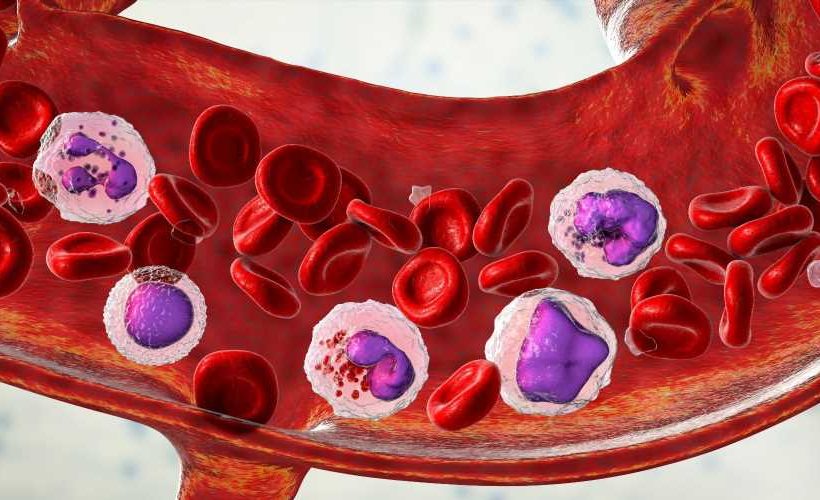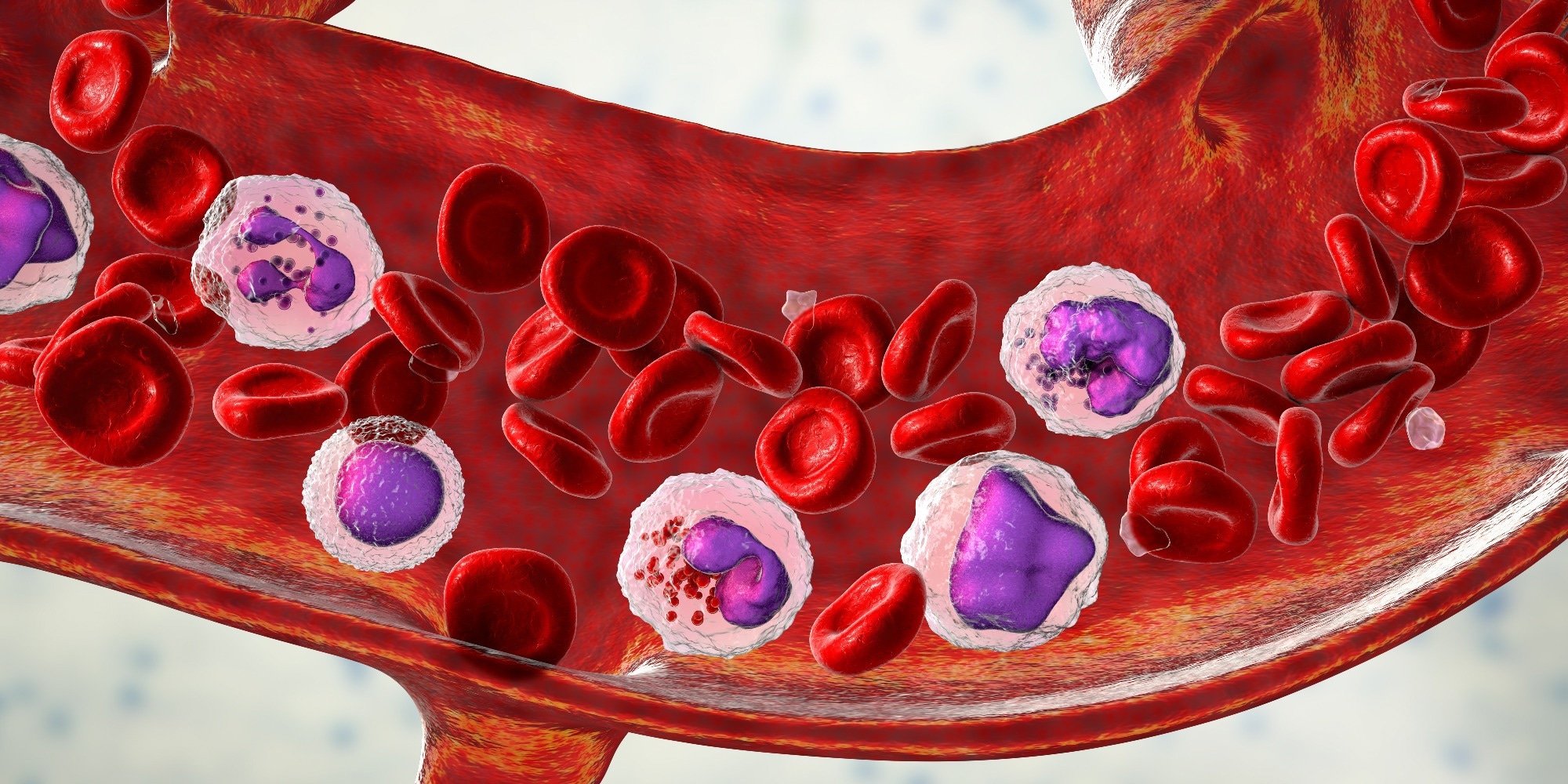
Role of M2 macrophage-derived exosomes in controlling neutrophil-mediated tissue injury in sepsis
In a recent study published in the Journal of Biomedical Science, researchers investigate whether M2 macrophage-derived exosomes (M2-Exos) could prevent inflammation-associated damage during sepsis-associated acute lung injury (ALI) by modulating abnormal polymorphonuclear neutrophil (PMN) behaviors.
 Study: Exosomal PGE2 from M2 macrophages inhibits neutrophil recruitment and NET formation through lipid mediator class switching in sepsis. Image Credit: Kateryna Kon / Shutterstock.com
Study: Exosomal PGE2 from M2 macrophages inhibits neutrophil recruitment and NET formation through lipid mediator class switching in sepsis. Image Credit: Kateryna Kon / Shutterstock.com
What happens during sepsis?
PMN recruitment and neutrophil extracellular trap (NET) generation during sepsis can cause organ dysfunction and ALI.
PMNs are the primary innate immune cells responsible for tissue damage, thus making them attractive therapeutic targets. Currently, there is no treatment that prevents or reverses PMN-mediated tissue harm without affecting their capacity to regulate microbial invasion.
Macrophages are important mediators in influencing the outcome of the inflammatory response. This has increased interest among researchers in understanding the interaction between PMNs and macrophages.
About the study
In the present study, researchers evaluate the impact of M2-Exos on PMNs during sepsis-related ALI by using a cecal ligation and puncture (CLP) murine model and in vitro co-culture experiments.
A CLP murine model was used to generate sepsis, following which M2-Exos were delivered intraperitoneally one hour after CLP. Hematoxylin and eosin (H&E) staining, immunohistochemistry (IHC), and immunofluorescence (IF) analyses were performed to examine pulmonary tissues for PMN infiltration, NET formation, and cellular injury.
The researchers also determined the influence of M2-Exos on PMN activity through the use of PMNs obtained from septic patients and healthy individuals in a co-culture. Blood samples were obtained from intensive care unit (ICU)-admitted individuals within 24 hours of their diagnosis of sepsis between January and November 2022. Blood samples were also obtained from sex- and age-matched healthy individuals.
Peripheral blood mononuclear cells (PBMCs) were isolated for macrophage cell culture. Celecoxib, a selective cyclooxygenase-2 (COX-2) inhibitor, was used to inhibit prostaglandin E2 (PGE2) expression in these cells.
Murine Raw264.7 macrophages were polarized to M2-type macrophages by adding murine interleukin 4 (IL-4) and IL-13 to the culture medium. Subsequently, quantitative reverse transcription-polymerase chain reaction (RT-qPCR) was performed to assess macrophage polarization.
Flow cytometry and Trypan blue staining were performed to assess PMN viability and reactive oxygen species (ROS) generation in the PMNs. Transwell assays were performed and NETs were quantified using myeloperoxidase (MPO)-based enzyme-linked immunosorbent assays (ELISA) and confocal microscopy. PGE2, leukotriene B4 (LTB4) and lipoxin A4 (LXA4) levels were measured using ELISA.
Arachidonic acid (AA)-based eicosanoids in exosome-treated polymorphonuclear neutrophils isolated from the study participants were detected by liquid chromatography-tandem mass spectrometry (LC-MS/MS).
The third International Consensus Definitions for Sepsis and Septic Shock (Sepsis-3) were used to diagnose sepsis. Individuals below 18 years of age, pregnant women, and those with active bleeding, severe anemia, and undergoing chemotherapy were excluded from the analysis.
Study findings
M2-Exos reduced NET formation and PMN migration, relieved lung damage, and increased septic mouse survival time. M2-Exos significantly reduced NET formation and PMN migration capability in vitro, which resulted in a lipid regulator class switch from pro-inflammatory LTB4 to anti-inflammatory LXA4 and 'reprogramming' PMNs by increasing 15-lipoxygenase (15-LO) levels.
Lipoxin A4 receptor antagonist treatment reduced the effect of M2-Exos on polymorphonuclear neutrophils and pulmonary damage. PGE2 enrichment of M2-Exos was required to increase 15-LO and 15-hydroxyeicosatetraenoic acid (15-HETE) levels in PMNs by acting on the prostaglandin P4 receptor. This led to the upregulation of lipoxin A4, which reduced ROS and C-X-C motif chemokine receptor 2 (CXCR2) expression and inhibited polymorphonuclear neutrophil function, which was reversed by BOC-2.
M2-Exos did not affect bacterial load in lung tissues, even when NET formation and PMN migration were inhibited. M2-Exos had an immunosuppressive effect on PMNs obtained from both healthy volunteers and septic patients.
Taken together, these findings suggest the potential of M2-Exos as a therapeutic candidate for PMN-regulated tissue injury during sepsis, in addition to providing important insights into the endogenous processes that regulate inflammation resolution.
The intraperitoneal injection of M2-Exos significantly inhibited the expression of various pro-inflammatory mediators including IL-1β, IL-6, and tumor necrosis factor-alpha (TNF-α) in lung tissues following CLP. This led to reduced PMNs in peripheral blood and lung tissues, thus indicating impaired recruitment from the bone marrow to the circulation.
Plasma double-stranded deoxyribonucleic acid (dsDNA) and soluble NET components were significantly lower in M2-Exos-treated mice than in M0-Exos-treated controls. PMN migration towards IL-8 was significantly reduced after M2-Exos treatment.
Flow cytometry analysis indicated increased CXCR2 and ROS expression in M2-Exos-treated PMNs after PD146176 treatment, which were reversed by LXA4 addition.
Conclusions
The study findings revealed the involvement of M2-Exos in modulating polymorphonuclear neutrophil movement and NET formation through lipid regulator class switching. Moreover, exosomal PGE2 from M2-type macrophages promoted LXA4 synthesis in PMNs by increasing 15-LO expression to modify PMN movement and NET formation capability, as well as through the downregulation of PMN CXCR2 and ROS expression.
Taken together, these findings indicate that M2-Exos may be an effective therapy for sepsis.
- Jiao, Y., Zhang, T., Liu, M. et al. (2023). Exosomal PGE2 from M2 macrophages inhibits neutrophil recruitment and NET formation through lipid mediator class switching in sepsis. Journal of Biomedical Science 30(62). doi:10.1186/s12929-023-00957-9. www.jbiomedsci.biomedcentral.com/articles/10.1186/s12929-023-00957-9
Posted in: Molecular & Structural Biology | Medical Science News | Medical Research News | Medical Condition News | Disease/Infection News
Tags: Anemia, Anti-Inflammatory, Arachidonic Acid, Bleeding, Blood, Bone, Bone Marrow, Celecoxib, Cell, Cell Culture, Chemokine, Chemotherapy, Chromatography, Confocal microscopy, Cytometry, ELISA, Enzyme, Exosome, Exosomes, Flow Cytometry, IHC, Immunohistochemistry, in vitro, Inflammation, Intensive Care, Interleukin, Interleukin 4, Ligation, Liquid Chromatography, Macrophage, Mass Spectrometry, Microscopy, Myeloperoxidase, Necrosis, Neutrophils, Oxygen, Polymerase, Polymerase Chain Reaction, Receptor, Sepsis, Septic Shock, Spectrometry, Transcription, Trypan Blue, Tumor, Tumor Necrosis Factor

Written by
Pooja Toshniwal Paharia
Dr. based clinical-radiological diagnosis and management of oral lesions and conditions and associated maxillofacial disorders.